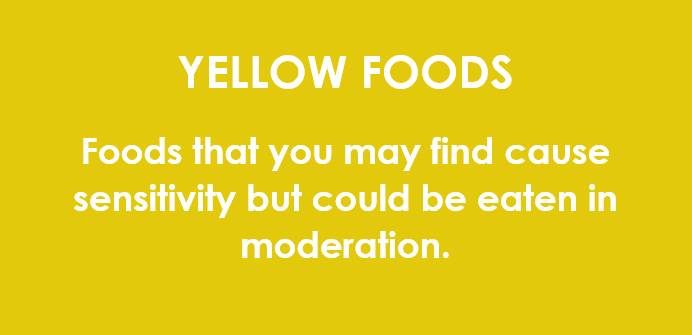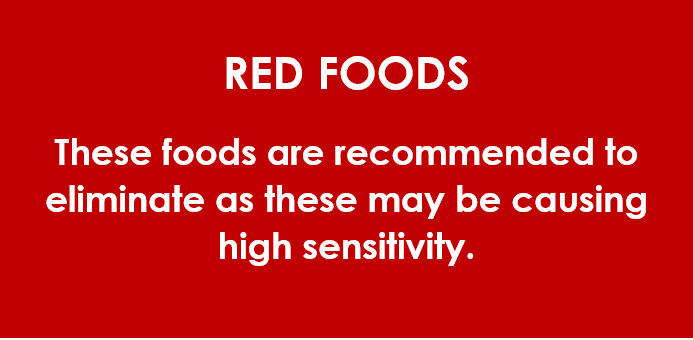WE ARE OPEN Monday to Saturday, 9am to 5pm
SHOP ‘TIL LATE on Wednesday 9am to 7pm
When experiencing uncomfortable symptoms such as bloating or tummy pain after we eat, it is a good idea to look to eating habits and diet to see if this could be causing the unpleasant physical reactions. In some instances, there are certain foods or ingredients that may be impacting on digestive health and a food intolerance test can help identify which ones are most likely to be causing digestive difficulty.
A food sensitivity test (or food intolerance test) is a helpful tool to guide you in which foods should be avoided, but it is important to note that this is NOT an allergy test. It is always worth investigating with your GP, as testing may be available via the NHS, however if you know you do not have an allergy but may have an intolerance then worth trying food sensitivity testing.
Scroll down the page to see our frequently asked questions regarding food sensitivity testing.

A food sensitivity can have very similar symptoms to an allergy – you may notice when you eat certain foods that you have digestive symptoms such as bloating, diarrhea, constipation or perhaps indigestion. It may be other symptoms too, such as brain fog, low energy levels, headaches, anxiety or joint pain.



You can order your test kit here online. If you want to talk through the options pop in and see us in store or call 01737 223499. Our team of registered Nutritional Therapists will guide you to the most suitable test for you.
In the meantime, you can click here to download a list of foods which are tested in each FoodPrint Test.
The cheapest of the FoodPrint range and includes some of the most common foods such as wheat, gluten, yeast, soya and dairy.
In addition to all the foods included in the FoodPrint 40+ this test also includes foods such fish, goat's milk, brazil nuts, pistachio, sheep's milk, buckwheat, mackerel, venison, tomato, cocoa, tea and coffee.
This is our most comprehensive food sensitivity test including everything in the FoodPrint 40+ and FoodPrint 120+ along with spelt, tapioca, seafoods, beans, flax, buffalo milk, casein, whey, quinoa and blueberries.
You will receive a report of your results within ten working days of the test being received at the lab. These will be sent you by email direct from Cambridge Nutritional Science.
If you wish to talk through your results, we offer a FREE 10 minute chat to help you understand what your report means and what to do next. This can be done by phone or you can pop in store to see our Nutritional Therapist.
If you have a lot of questions, further support is available in our 30 minute Food Test Results Follow-Up over the phone with registered Nutritional Therapist Alison. This is a great opportunity for you to explore your results in more detail, ask lots of questions and get meal inspiration – particularly useful if some of your ‘usual’ foods are now restricted. This can be booked any time after you have received your results and costs £30.
The report from CNS is a very useful tool for our customers to be able to navigate shopping, knowing what they can and can’t eat and of course we are here in store to help provide guidance on your results and show you options we have in store. We never advocate leaving out food groups from your diet and would look to find healthy alternatives if you have identified foods that are problematic.
If you have been avoiding certain foods that you suspect are problematic and then decide to do the intolerance test, you would need to start eating those foods before testing (please see our FAQ about when and how to do this). Don’t forget, this is a food sensitivity test NOT an allergy test, therefore you would eliminate the problematic foods for a period of three months to start with, possibly longer if needed. After that you can reintroduce those foods slowly. How to do this is explained in your guidebok that comes with your results, this can also be discussed with our Nutritional Therapist as detailed above.
The Food Sensitivity Testing we offer is NOT allergy testing. If you suspect that you have an allergy we recommend you speak with your GP.
IgG stands for Immunoglobulin (type G). Immunoglobulins are a class of proteins that function as antibodies produced by the immune system in response to foreign bodies entering the body. There are several different types of immunoglobulins with IgA, IgE, IgG, IgM being the most well-known.
Generally, foods are broken down during digestion into their component parts e.g., amino acids, glycerides etc. These pass harmlessly through the gut into the bloodstream. However, occasionally small fragments of partially digested or undigested foods can pass through the gut wall into the bloodstream where they are recognised by the immune system as being ‘foreign’. The immune system responds by making IgG antibodies to these foods.
When a food causes the body to produce high levels of IgG then these antibodies combine with the protein in the food to form an ‘antigen-antibody complex’. These complexes are usually eliminated by other cells in the immune system. However, if the immune system is overloaded, these complexes become deposited in tissues within the body, causing chronic inflammation and the subsequent production of symptoms.
When a food causes the body to produce high levels of IgG then these antibodies combine with the protein in the food to form an ‘antigen-antibody complex’. These complexes are usually eliminated by other cells in the immune system. However, if the immune system is overloaded, these complexes become deposited in tissues within the body, causing chronic inflammation and the subsequent production of symptoms.
Yes, some people do have high IgG levels to certain foods but do not have any symptoms at all. This is most likely due to their immune system being extremely efficient at clearing away the antigen-antibody complexes before they have chance to be deposited in the tissues and cause a problem.
It is true that certain common foods are more likely to show a positive result e.g., wheat, dairy, soya. The reason for this is that these foods are consumed on a regular basis in our diet and along with digestive issues this can increase the likelihood that the body may react to them. While an elimination diet will always be the gold standard, the benefit of doing a food sensitivity test is that it will be able to quickly show which foods eaten on a regular basis are a potential problem. In addition, the tests can highlight more unusual foods which a person may not have considered removing from their diet.
CNSLab’s existing policy for a lower age limit on testing for IgG food antibodies is that we do not recommend testing on children under the age of 2 years. We base this on the European Society for Paediatric Gastroenterology, Hepatology, and Nutrition Guidelines for the Diagnosis of Coeliac Disease 2012, which states that there is a possibility of false negative results occurring in infants younger than 2 years of age. This related to the fact that the infant gut is more permeable than that of an adult coupled with immature mucosal immunity that is still in the learning and development stage. We have used this criterion as antibody measurements in Coeliac Disease are comparable to food IgG measurements used in our food sensitivity tests. However, we are aware that there are in fact no published guidelines that specifically indicate a minimum age for testing for such IgG antibodies, for example the guidelines for testing for coeliac antibodies indicate that such testing can be performed any time after the introduction of gluten into the diet. Therefore, where such requests are received from a statutory regulated professional the decision of when and what tests to perform will remain the responsibility of the requesting clinician.
A food sensitivity test is not recommended during pregnancy as the immune system is suppressed. However, 4-6 weeks after giving birth should be ok.
The efficacy of a diet based on the measurement of IgG antibodies specific for food components has been demonstrated in several conditions, both in independent studies and clinical practice. Excellent results have been obtained in patients with migraine, IBS, and obesity.
Customers should avoid the use of immunosuppressant medication if possible if performing these tests, as they may have an impact upon the results. For more information on medications that might affect food sensitivity test results, please contact us on info@inside-out-health.com
The efficacy of a diet based on the measurement of IgG antibodies specific for food components has been demonstrated in several conditions, both in independent studies and clinical practice. Excellent results have been obtained in patients with migraine, IBS, and obesity.
Food extracts are ‘printed’ onto nitrocellulose ‘pads’™ on a glass microscope slide, together with calibration standards and controls. A blood sample provided by the patient is diluted and dispensed onto each printed microarray. Food IgG antibodies, if present, bind to the food extracts and the results are measured by a high-resolution scanner, before being calibrated against the standards using the FoodPrint reporting software to give quantitative results. This software then produces a tailor-made printout of the final food IgG antibody result for each food on the requested food panel.
In general, we recommend that you follow your normal diet, so that the test will reflect what you usually eat. If you are avoiding a food because you suspect or have a confirmed diagnosis of a food allergy, then you should continue to avoid that food. However, if you have specifically avoided a food for more than three months e.g., cow’s milk, which used to be part of your normal diet and you would like it tested, we would recommend it is reintroduced. The recommendations are to reintroduce the food for 1 week eating a normal portion of that food at least once daily before taking your blood sample. If symptoms occur once the food is re-introduced, we recommend that you discontinue that food and conclude you are still intolerant to it.
Although it is advisable to completely fill the tube, a half-filled microvette tube should be enough to run the test. If there are any problems with a sample the lab will let the customer know. However, if you are ordering two tests, we can test from one sample if you provide a full microvette.
Yes, it does need to be stored in the fridge with the lid secured if not sending on the same day.
Yes, it does need to be stored in the fridge with the lid secured if not sending on the same day.
Yes, it does need to be stored in the fridge with the lid secured if not sending on the same day.
A finger prick blood sample is required. Results are available within 10 working days.
FoodPrint screens for all IgG subclasses 1-4, with the numbers on the test report representing the total IgG concentration for each food extract in the selected panel.
We respect your choice to wear a face covering when shopping in store. You may see our team members wearing one too.
Payments can be made by card or cash in store. Online orders are paid for by card over the phone.
We do not accept £50 notes or American Express.